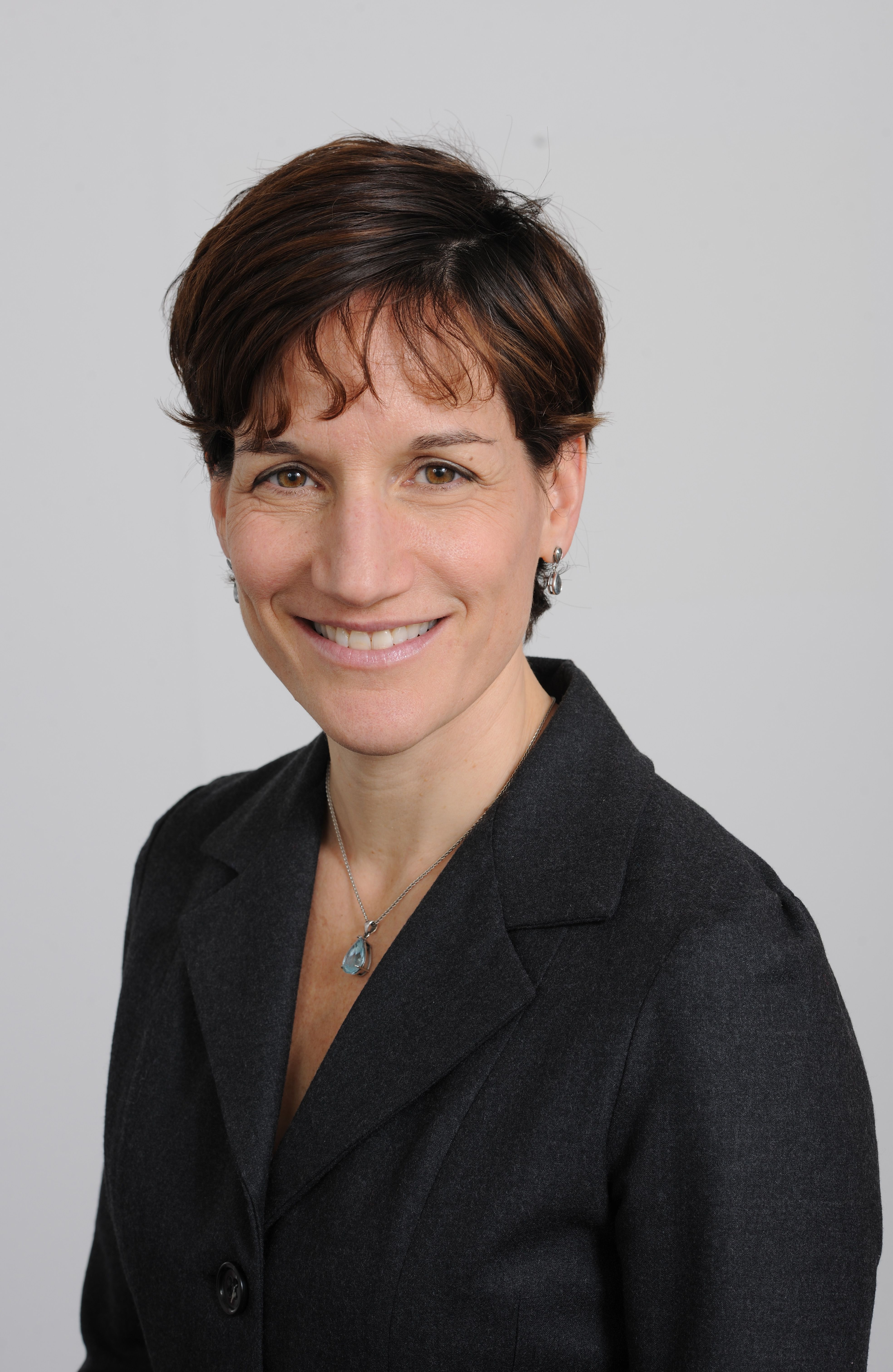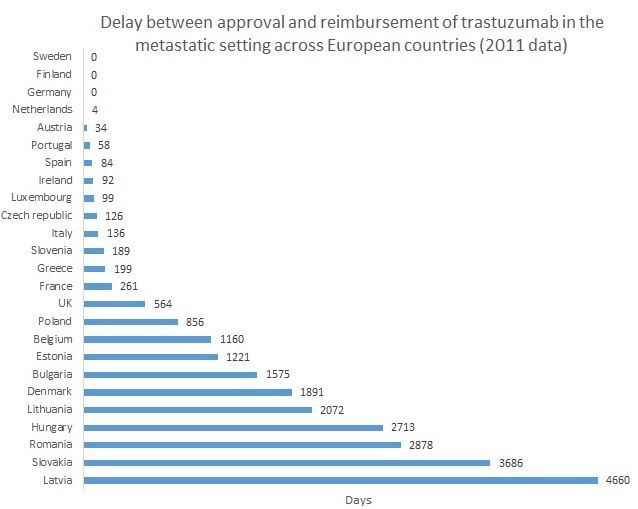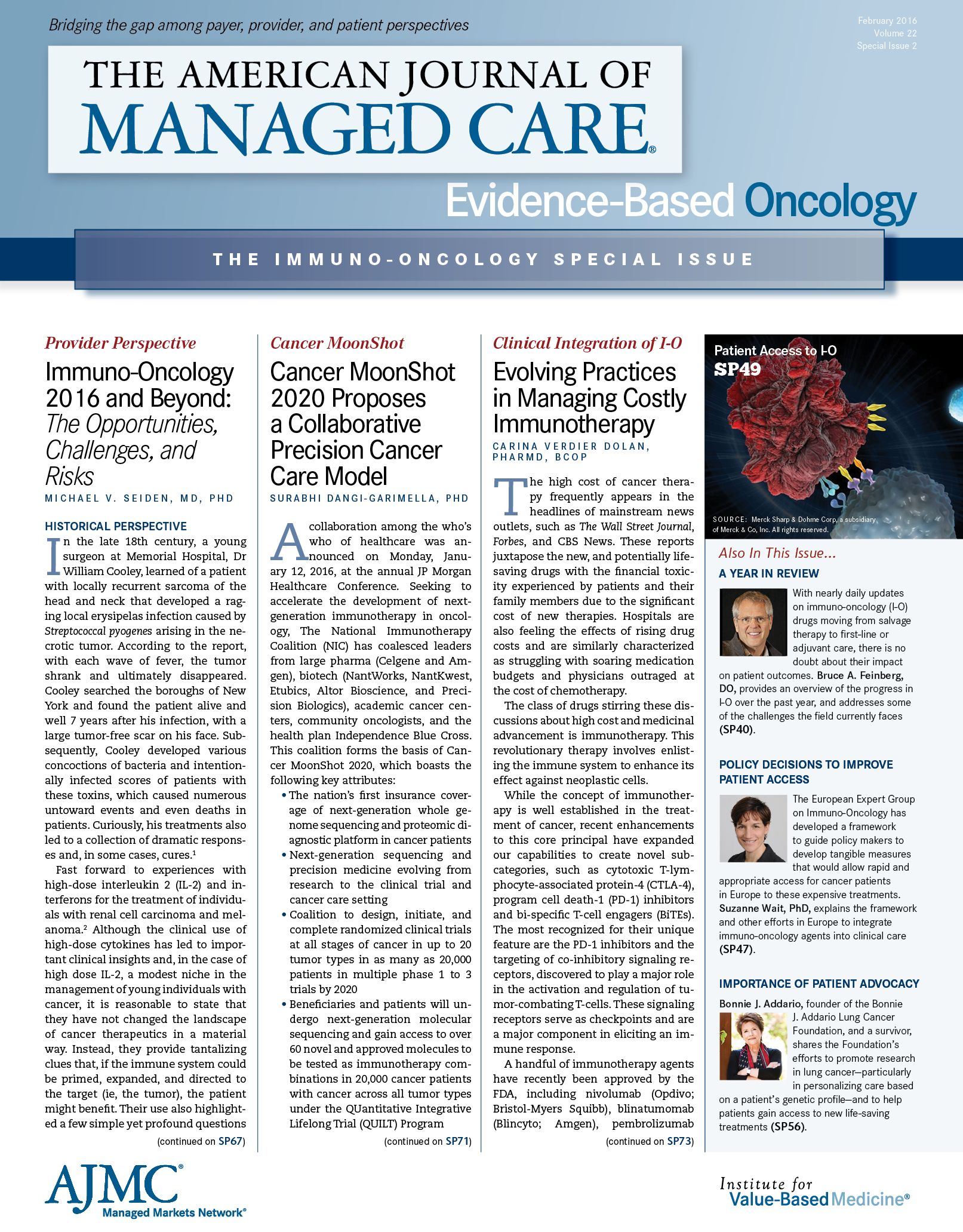Publication
Article
Evidence-Based Oncology
Access to Immuno-Oncology Therapies - European Policy Perspective
Author(s):
Ensuring rapid, appropriate, and sustainable access to immuno-oncology therapies for patients in Europe: what role can policies play?

Immuno-oncology (I-O) therapies are expected to transform the treatment landscape for many forms of advanced cancer in years to come. The pace of development of these agents is remarkable, with multiple agents targeting different immune mechanisms being investigated for the treatment of some of the most common and most difficult-to-treat cancers.1
Understandably, patient groups are urging policymakers to make these innovative treatments available to patients as quickly as possible. However, the price tag for these new drugs is high, and policymakers have to find ways to accommodate these new agents within financially constrained healthcare budgets.2
Figure 1
It was in light of these political realities that the European Expert Group on Immuno-Oncology, an independent network of patient representatives, cancer clinical experts, scientists, and policymakers, issued the Policy Action Framework for Immuno-Oncology in 2014,3 with the aim to guide policymakers toward concrete steps that may create an enabling policy environment for rapid and appropriate access to I-O drugs across Europe.4 The Framework proposed 5 concrete steps that policymakers may take to foster access to I-O treatments (). One year after its publication, we look at how some of these proposals have unfolded across Europe.
More Flexible, and More Efficient, Regulatory and Access Pathways
The science of I-O is continually evolving, and experts have called for adaptation to clinical development pathways5 and trial endpoints6,7 to best reflect the clinical patterns observed with I-O agents and capture their full benefits.8 Experts have also called for greater flexibility in regulatory pathways for promising new cancer drugs, including I-O agents, to ensure they are made available to patients as quickly as possible.9 With this goal in mind, the European Medicines Agency (EMA) is piloting a number of adaptive licensing schemes, which allow approval decisions to be based on an evolving set of data for drugs that show promising results in early phase clinical trials, with an ultimate aim to make them available to patients more quickly.10,11
Accelerating the drug approval process, however, is only one part of the access equation. In Europe, although drug approval is centralized with the EMA, each country maintains jurisdiction over the financing of its healthcare system. Access frameworks vary considerably across the member states, with some including a formal health technology assessment (HTA) and others relying on pricing and reimbursement mechanisms. Each access process also has its own evidentiary requirements. As a result, there are significant differences in the time it takes new drugs approved by the EMA to become available to patients in different European countries.12

Figure 1. Recommendations of the Action Framework on Immuno-Oncology
These disparities in access have drawn considerable attention from patient groups and politicians alike.13 In 2012, a European Commission Directive reduced the limit for the duration of pricing and reimbursement processes in member states from 180 days to 120 days.14 The European Network for Health Technology Assessment has also tried to harmonize evidence requirements for new drugs across countries.
Figure 2
Despite these efforts, significant delays in access still remain in many countries, particularly in Eastern Europe.12 This is illustrated in the case of trastuzumab for the treatment of metastatic cancer in .15

Figure 2. Delay in Access to Trastuzumab in Metastatic Breast Cancer Across Europe, 2011 Data
National-level reimbursement or coverage is critical; however, it does not necessarily result in patients having access to new drugs, as funding decisions are increasingly decentralized to the regional and sometimes the individual hospital level.2 Inequities in access to all aspects of cancer care are widespread and are potentially increasing with the recent austerity measures introduced in a number of European countries.13 Out-of-pocket payments are also increasing in light of limited public funding for new drugs in many countries, posing important ethical questions for societies whose healthcare systems are historically based on principles of solidarity and universal access.
Integrating Cancer Innovations Into Funding Streams and Treatment Pathways
To secure access to innovative, but high-priced, drugs, a number of countries have chosen to create special funds to finance these drugs outside of the mainstream drugs budget. In Italy, an “innovation fund” exists, which grants potentially innovative drugs preferential treatment in terms of adoption and pricing. The fund is partially financed from savings from expired patents on older drugs. The United Kingdom created the Cancer Drugs Fund (CDF) in 2011 in response to significant pressure from patient groups and the general public to provide access to several cancer drugs that were already available in other European countries. The CDF has thus far allowed up to 74,000 cancer patients access to drugs that were either not considered suitable for public funding by the National Institute for Health and Clinical Excellence (NICE) or that were still awaiting review by the Institute and not yet available for use in patients. However, NICE has been criticized on many grounds and its future remains uncertain.16,17
Another trend being extended to I-O agents is the increased adoption of managed-entry agreements (or risk-sharing schemes)18 between payers and drug manufacturers. The taxonomy of these agreements varies. However, they are all based on the principle of conditional access: payers may grant access to a new drug based on a rebate or price discount, with the expectation of achieving a certain level of performance or outcomes (performance-linked payments) or while waiting for future evidence of the drug’s impact on clinical practice (coverage with evidence). Thus, access decisions are no longer a one-off, but become dynamic and evolve over time. Under the conditional reimbursement scheme in the Netherlands, for example, a price for certain innovative drugs prescribed in hospitals is set based on international reference prices, and conditional access is given up front.19 Outcomes, including patient adherence and cost-effectiveness, are then tracked for 4 years in select care settings against pre-established criteria. If, after 4 years, these criteria are not met, manufacturers must retroactively pay back the associated drug sales to the healthcare system.20
The above schemes may be seen as a pragmatic way for payers to grant rapid, albeit limited, patient access to potentially innovative drugs while they wait for real-world data to be collected that can demonstrate the effectiveness of these new drugs in clinical practice.21 However, risk-sharing schemes are often adopted at a local or regional level and can be complex and resource-intensive to implement, making widespread implementation difficult.21 Also, no evaluation of the impact of existing schemes currently exists.18 As a result, it remains largely unknown whether existing schemes have improved access and outcomes for patients or led to overall long-term savings for payers.
Measuring What Matters to Patients
The most important recommendation of the Action Framework is that the evaluation of I-O drugs be based on what matters most to patients: long-term, quality survival.6 Recently, the American Society of Clinical Oncology and the European Society for Medical Oncology have focused their attention on how to best measure benefits of new cancer drugs within clinical trials, proposing new scales that may form the basis for evaluations of all new cancer drugs.22-24 However, these scales are insufficient in themselves to assess the “value” of new drugs, as they do not include any consideration of costs, patient preferences, or quality of life.25 Thus, how they may help improve current methodologies used in access decisions—for example, by HTA agencies—still remains to be seen.
The evaluation of I-O drugs should be based on their impact—clinical and economic—on the entire cancer pathway and care experience for patients.25 For example, the increased drug acquisition costs of I-O drugs should be weighed against their impact on the whole care pathway, such as reducing the need for hospitalization or other types of care. Also, the potential for long-term survival—in terms of reduced morbidity, extended life, and enhanced productivity over many years—should be factored into the evaluation of all new I-O agents.
EBO
In conclusion, with ever-present pressures on our healthcare system, researchers, industry, regulatory agencies, and payers need to work together to try to continually improve outcomes for cancer patients despite financial pressures. To achieve this, we need to find equitable and financially sustainable ways of integrating the most valuable innovations in cancer care into our cancer plans, treatment pathways, and healthcare budgets.
Suzanne Wait, PhD, is director of The Health Policy Partnership Ltd, a London-based consultancy specializing in health policy research and analysis.
Address for correspondence
Suzanne Wait, PhD
The Health Policy Partnership Ltd.
5 Chancery Lane,
London WC2A 1LG
United Kingdom
E-mail: suzanne@hpolicy.com
Website: www.healthpolicypartnership.com
References
Funding: No funding source to declare.
- What is cancer immunotherapy? Cancer Research Institute website. http://www.cancerresearch.org/cancer-immunotherapy/what-is-cancer-immunotherapy#sthash.b4NeQEhi.dpuf. Accessed January 14, 2016.
- Kudrin A. Reimbursement challenges with cancer immunotherapeutics. Hum Vaccin Immunother. 2012;8(9):1326-1334. doi: 10.4161/hv.20550.
- The European Expert Group on Immuno-Oncology. Immuno-oncology: a policy action framework. European Cancer Patient Coalition website. http://www.ecpc.org/Documents/Policy&Advocacy/Immuno-Oncology/Event%2019th%20Nov%202014/IO%20action%20framework%20FINAL%20Dec14%20lores.pdf. Published 2014. Accessed January 14, 2016.
- de Lorenzo F, Wait S, Karaca B, Britten C, van den Bulcke M; European Expert Group on Immuno-Oncology. Greater patient access to immuno-oncology therapies—what can policymakers do? Ecancermedicalscience. 2015;9:ed48. doi: 10.3332/ecancer.2015.ed48.
- Hoos A, Britten C, Huber C, O'Donnell-Tormey J. A methodological framework to enhance the clinical success of cancer immunotherapy. Nat Biotechnol. 2011;29(13):867-870. doi: 10.1038/nbt.2000.
- Ellis LM, Bernstein DS, Voest EE, et al. American Society of Clinical Oncology Perspective: raising the bar for clinical trials by defining clinically meaningful outcomes. J Clin Oncol. 2014;32(12):1277-1280. doi: 10.1200/JCO.2013.53.8009.
- Wolchok J, Hoos A, O'Day S, et al. Guidelines for the evaluation of immune therapy activity in solid tumors: immune-related response criteria. Clin Cancer Res. 2009;15(23):7412-7420. doi: 10.1158/1078-0432.CCR-09-1624.
- Johnson P, Grenier W, Al-Dakkak I, Wagner S. Which metrics are appropriate to describe the value of new cancer therapies? Biomed Res Int. 2015;2015:865101. doi: 10.1155/2015/865101.
- Stewart D, Kurzrock R. Cancer: the road to Amiens. J Clin Oncol. 2009;27(3):328-333. doi: 10.1200/JCO.2008.18.9621.
- Eichler HG, Oye K, Baird LG, et al. Adaptive licensing: taking the next step in the evolution of drug approval. Clin Pharmacol Ther. 2012;91(3):426-437. doi: 10.1038/clpt.2011.345.
- European Medicines Agency. Pilot project on adaptive licensing. European Medicines Agency website. http://www.ema.europa.eu/docs/en_GB/document_library/Other/2014/03/WC500163409.pdf. Published March 19, 2014. Accessed January 14, 2016.
- Patients’ W.A.I.T. Indicator — report 2011. European Federation of Pharmaceutical Industries and Associations website. http://www.efpia.eu/documents/33/64/Market-Access-Delays. Published August 2011. Accessed January 15, 2016.
- Europe of Disparities in Cancer Working Group. Challenging the Europe of disparities in cancer: a framework for improved survival and better quality of life for European cancer patients. European Cancer Patients Coalition website. http://www.ecpc.org/Documents/Policy&Advocacy/Europe%20of%20Disparities/ Europe%20of%20Disparities%2027th%20Sept%202015.pdf. Published November 2015. Accessed January 16, 2016.
- Faster access of patients to new medicines — revised transparency directive [press release]. Brussels, Belgium: European Commission; March 1, 2012. http://europa.eu/rapid/press-release_MEMO-12-148_en.htm?locale=en. Accessed January 14, 2016.
- Ades F, Senterre C, Zardavas D, et al. An exploratory analysis of the factors leading to delays in cancer drug reimbursement in the European Union: the trastuzumab case. Eur J Cancer. 2014;50(18):3089-3097. doi: 10.1016/j.ejca.2014.09.011.
- Morse A. Department of Health and NHS England: investigation into the Cancer Drugs Fund. publication. National Audit Office website. https://www.nao.org.uk/wp-content/uploads/2015/09/Investigation-into-the-Cancer-Drugs-Fund1.pdf. Published September 15, 2015. Accessed January 14, 2016.
- Consultation on proposals for a new Cancer Drugs Fund (CDF) operating model from 1st April 2016. National Institute for Health and Care Excellence website. https://www.nice.org.uk/Media/Default/About/what-we-do/our-programmes/technology-appraisals/cdf-consultation-document.pdf. Published 2015. Accessed January 15, 2016.
- Hofmarcher T, Jönsson B, Wilking N. Access to high-quality oncology care across Europe. Janssen website. http://janssen-emea.com/sites/default/files/IHE_CC_Report_single_pages.pdf. Published 2014. Accessed January 14, 2016.
- Delwel GO. Guidance for outcomes research for the assessment of cost-effectivenes of in-patient medicines. Zorginstituut Nederland website. http://www.zorginstituutnederland.nl/binaries/content/documents/zinl-www/documenten/publicaties/publications-in-english/2008/0812-guidance-for-outcomes-research/0812-guidance-for-outcomes-research/Guidance%2Bfor%2BOutcomes%2BResearch.pdf. Published 2008. Accessed January 15, 2016.
- Blommestein HM, Franken MG, Verelst SG, et al. Access to expensive cancer drugs in Dutch daily practice: should we be concerned? Neth J Med. 2014;72(4):235-241.
- Neumann PJ, Bliss SK, Chambers J. Therapies for advanced cancers pose a special challenge for health technology assessment organizations in many countries. Health Aff (Millwood). 2012;31(4):700-08. doi: 10.1377/hlthaff.2011.1309.
- Cherny N, Sullivan R, Dafni U, et al. A standardised, generic, validated approach to stratify the magnitude of clinical benefit that can be anticipated from anti-cancer therapies: the European Society for Medical Oncology Magnitude of Clinical Benefit Scale (ESMO-MCBS). Ann Oncol. 2015;26(8):1547-1573. doi: 10.1093/annonc/mdv249.
- Schnipper L, Davidson N, Wollins D, et al; American Society of Clinical Oncology. American Society of Clinical Oncology statement: a conceptual framework to assess the value of cancer treatment options. J Clin Oncol. 2015;33(23):2563-2577. doi: 10.1200/JCO.2015.61.6706.
- Tabernero J; ESMO Executive Board. Proven efficacy, equitable access and adjusted pricing of anti-cancer therapies: no ´sweetheart´ solution. Ann Oncol. 2015;26(8):1529-1531. doi: 10.1093/annonc/mdv258.
- Schilsky R. Moving from evaluation to value in cancer care. Clin Cancer Res. 2014;21(7):947-949. doi: 10.1158/1078-0432.CCR-14-2533.






